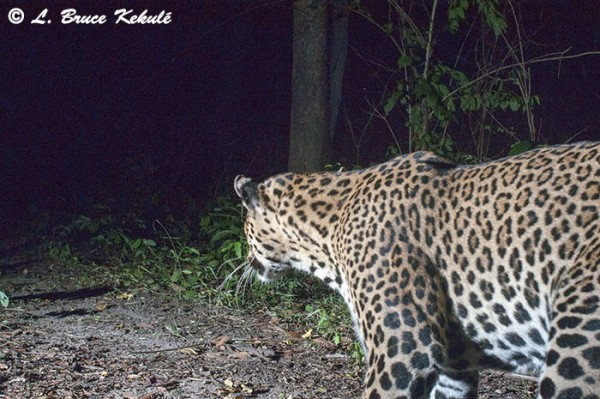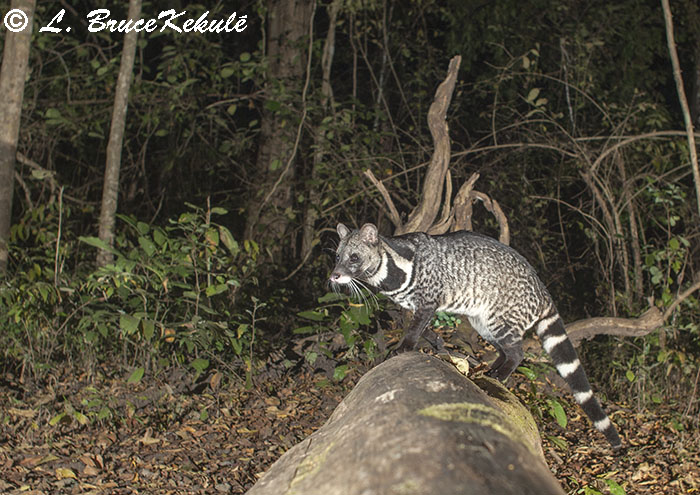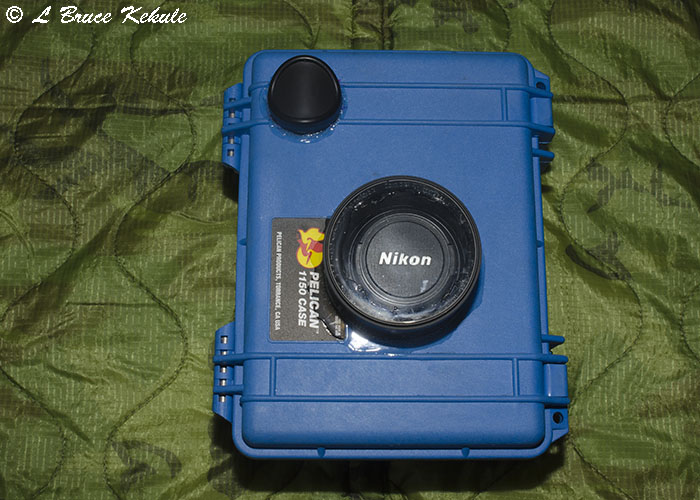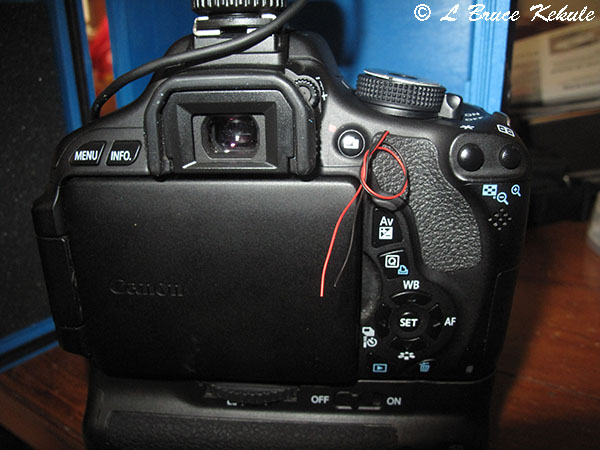Posts Tagged ‘trail camera’
Indochinese tiger male caught on video and DSLR
A video and still photos of an Indochinese tiger in the Western Forest Complex of Thailand. This male cat was camera trapped in the afternoon and then in mid-morning…a beautiful carnivore.
The message is the same: these magnificent cats need 100% increase in protection and enforcement as they have become extremely rare in the wild. Unfortunately, some bad people chase after them for bones to be sold on the black market…! The main worry is that help will come too little and too late to really save the tiger and other creatures of the Thai forest…! Enjoy the beauty of raw nature but never forget this message: We need to work hard to change things so these magnificent cats will continue to roam the forest…!
Canon 600D catches a big male tiger
A lucky catch in late afternoon…!
I was finally able to set my Canon 600D with two Nikon SB-28 flashes on a trail where I previously set my BFOutdoors P41 and captured tiger, yellow and black phase leopards plus many other creatures found in this forest. It has been a great location and the set has been very productive.
However, the sensor was not working properly (old #5 with refresh) and run the batteries down. I recently got the #5 program without refresh (many thanks to Johnnydeerhunter on Camtrapper.com) and installed the new chip. It worked like a charm and the Canon will fire off 6 shots a second and wake-up the flashes. The cam and flashes were working great when I left it. I also set up a DXG 567 ‘blackflash’ homebrew video cam close to the Canon to record any animals that passed by (I’ll be posting a video of this cat passing the cam twice).
It has been extremely wet and for some odd reason, the flashes stopped working but the camera continued to crank along. I was pleasantly surprised when I visited the location a couple days ago. On the card was a male tiger that walked past the cam at 4:40PM on October 4th but the flashes did not trigger which created some undesirable noise in this image. This shot is the best of the lot with some highlights on his family jewels and legs, plus a superb back-lit forest. Needless to say, I was still happy with the results and will put this Canon back ASAP…the location certainly has potential and my hope for that black leopard continues…one of these days….Enjoy…!
Nikon D300s catches an Asian Leopard
A male cat shows off its family jewels…!
A male leopard with its reproductive organs in full swing…Shot No: 6.
Back at the end of June, I pulled a card from my D300s DSLR trail cam at the ‘big cat trailhead’ and when I looked, I did not see anything so I threw the card in the with the rest of my CF cards.
Shot No: 1
It was somehow put into my D3s but fortunately I did not format it. After doing some work while in the forest last week, I pulled both cards (Nikon D3s had two CF card slots) and downloaded them.
Shot No: 2
Imagine my surprise…! There was a male leopard and he had been captured at night while walking past the D300s. Where the heck did that come from…?
Shot No: 3
I guess my short-term memory is on the blink. Unfortunately, the other two flashes were dead creating a horrible shadow…!
Shot No: 4
Needless to say, I’m lucky I did not lose these shots and of course, shot No: 6 is my favorite…enjoy…!
Shot No: 5
Nikon D300s set to low continuous.
Nikon 35mm manual lens.
ƒ11 @ 1/125 ISO 400
Single SB-28 set to full (the other two flashes did not fire and were dead).
SSII sensor #6 chip – Pelican 1150.
Nikon D700 captures two civet species
My full frame DSLR trail cam still working well…!
Large Indian civet up on the log…!
Just returned from the Western Forest Complex in Thailand where I checked out my Nikon D700 on the log. It continues to capture some amazing creatures that thrive in this biosphere and the ‘log’ has proven to be a goldmine for me…!
Large Indian civet up-closer…!
A large Indian civet Viverra sibetha jumped up on the log and the D700 fired off two shots. This large civet is nocturnal and common in this forest. This critter came up close but then jumped off after the flashes fired again.
Masked palm civet a few days later….!
A few days later, a masked palm civet Paguma larvata also got up on the log and came right up to the cam. Largely arboreal, they also hunt on the ground.
Up-close…!
I did use some ‘coon bait’ by Marsyada’s Lures from Hazei Township, PA which worked real well to lure these carnivores. It was a nice catch and I’m sure they will return.
Up real close…!
Unfortunately, a tiger came up to the log but saw the red LEDs on a Bushnell setup across from the D700 and did not cross over but went around and so I missed the big cat but got him on video. Hopefully, it’ll pass over next time..Enjoy…!
Wild Thailand Part One and Two
For the first time, a snarling tiger shows what their reaction is to a video cam with red LEDs when actuated at night. This male tiger is a resident at this location in the ‘Western Forest Complex’…a black leopard also passed the cam several times but did not actually look at the LEDs and so no reaction was recorded.
At the second location, the tigers did not seem too bothered by the red blob…! I now have a few cams including my Nikon D700 set-up here and hopefully will catch a tiger with my DSLR trail cam…!! Please enjoy these videos and even though they are a bit fuzzy, still show Thailand’s amazing natural heritage at its best.
Canon-Nikon ‘Hybrid’ DSLR trail cam
A 600D/T3i and a Nikon manual 50mm ƒ1.4 lens combination
I recently acquired a Canon 600D/T3i DSLR to be used as an HD video trail cam but with its present Canon programming, it will not stay on stand-by in video mode for more than 10-15 minutes and then shuts down, and must be restarted manually. The control circuits for the still camera and the video are separate. For the moment, to control the 600D in video mode as a trail cam, a remote triggering device or a hack to the video switch on the camera is needed and connected to a motion sensor.
Also, a sensor board with the right programming to turn the cam on, go into recording mode and take a video clip for 60 seconds and then shut the cam down for a delay (as short as possible). If there is still motion, start-up and a repeat of the video cycle will activate the cam again. I can hack an IR remote or the video switch on the Canon to accomplish this task for now. More battery power for the cam will probably be needed and will be doing some serious testing real soon. On the video remote option, and since it is IR controlled, it would have to be in front (line of sight) or next to the sensor inside the case.
 Canon-Nikon ‘Hybrid’ SSII Pelican 1150.
Canon-Nikon ‘Hybrid’ SSII Pelican 1150.
However, there is a ‘Magic Lantern’ firmware program for the Canon to control it with a shutter release cable but I’m not sure at the moment. That seems to be in the field of programming, something I don’t do. I’ll leave that to the pros but will be looking into the ‘Magic Lantern’ program at a later date. For now, I will be setting this cam to shoot stills and hopefully test it in video soon.
The Nikon lens is a very old manual 50 ƒ1.4 I’ve had for ages back in the days when only glass and metal were used for lens materials, and clarity and sharpness is superb plus it’s very robust. A converter was bought to allow the Nikon to fit on the Canon. I’m now using manual Nikon lenses except for a Canon 400D and Nikon D90 with their newer 50mm glass/plastic lenses. I love the old prime manual lenses from Nikon.
 Hybrid in aluminum ‘elephant proof’ box.
Hybrid in aluminum ‘elephant proof’ box.
The 600D fits easily in a Pelican 1150 using a 77mm diameter aluminum tube snorkel and a 77mm UV filter for the lens, and a Snapshot Sniper SSII #5 board/HPWA connected by a Canon shutter release cable (shortened) with a 90-degree plug. The cam is set to ‘continuous mode’ and fires off 6 or more shots on each trigger. It is very fast…!
 Nikon SB-600 with PT-04NE FM radio transmitter.
Nikon SB-600 with PT-04NE FM radio transmitter.
A PT-04NE FM radio transmitter is used on the Canon and two receivers trip Nikon SB-600 and a SB-800 housed in ‘tupperware’ type plastic boxes with 4-locks on the lid and will be airtight. I will also have another spare flash (a generic ‘Speedlight’ 850/Canon flash mount) with a PT-04 receiver in a slightly larger plastic box. I got this idea from Cutter on the ‘Outdoor Talk’ forum that used them for externals and many thanks to him for a great idea. I will certainly be using these boxes for all my future slave flashes and some external battery builds.
 Nikon SB-600 with PT-04NE FM radio transmitter in a ‘tupperware’ box.
Nikon SB-600 with PT-04NE FM radio transmitter in a ‘tupperware’ box.
Another sensor to be used with this cam will be an old ‘TrailMaster’ TM1500 ‘active infrared’ unit housed in two separate aluminum boxes to be securely attached to trees between a trail or over a log for precise tripping. The only drawback is the loose wire between the receiver and cam…! However, I will be using special aluminum braided telephone cable to connect the two as rodents and other small creatures could chew/gnaw on the wire. It will also have to be secured to the tree using clips and lag screws, and then buried in the dirt.
 Nikon SB-800 with Nikon SD-8 battery pack and PT-04NE FM radio transmitter.
Nikon SB-800 with Nikon SD-8 battery pack and PT-04NE FM radio transmitter.
As usual, the cam and three-four flashes are housed in my aluminum ‘elephant proof’ boxes that are bolted to trees in conjunction with ‘Python’ lock cables. Due to time restraints and a cracked molar, I did not get the boxes done in time for this post but they will be finished soon. Anyway, that’s the way these very strong boxes look from the welder. The ‘TrailMaster’ units are also shown in unfinished boxes. When they are all done, I will post some photos later.
 A TrailMaster TM-1500 ‘active infrared’ unit in unfinished boxes.
A TrailMaster TM-1500 ‘active infrared’ unit in unfinished boxes.
The cam will be set to manual focus and exposure: ƒ8 – 1/125 @ ISO 400 to test the Canon/Nikon combo and depending on how the photos come out, can increase ISO. Look forward to setting this cam not far from the ‘Big Cat Trailhead’ with images and videos to follow…!
As there is loads of space in the 1150, I’ll be able to add various items needed for video including another sensor with a sister board to get white light for the video at night. I’m certain a large battery with loads of power will be needed close by…I’ll be addressing these issues as I go forward with this project.
The hack to the camera to operate video only is as follows. It is a difficult modification but is doable. Only two wires – positive and negative is needed. I’m waiting for a chip for my board with the right programming.
Canon 400D DSLR catches a ‘black leopard’
Once again, the ‘Big Cat Trailhead’ situated deep in the Western Forest Complex continues to be a real hotspot for the big cats. Both black and yellow phase leopards were captured on digital stills and video at this location.
In July at the beginning of the rainy season, I set my Canon 400D down low (about two feet off the ground) on a tree at the trailhead wanting a real low-down set-up. When I returned, the lens was completely covered by sand and mud from extremely heavy rain and splatter…and no photos were on the card: a disappointment…! I then moved the cam way up about five foot and angled down about 45 degrees.
After some three weeks, I was back and a black leopard had passed the cam at night. Only one flash went off (a Nikon SB-28) and just one good shot was acquired. A bunch more were captured of the cat but it was standing half-out of the frame. The Canon flashes (270EX) have proven to not be very reliable and I will probably just drop them out eventually. The Nikon flashes (especially the SB-28s) are better and last longer on stand-by.
Even though the composition is not the greatest, it’s still a good record shot…I have since moved the cam back down to about three feet hopefully to catch a full-frame head-on shot of this melinestic creature. I have now caught this cat 5-6 times including a beautiful daytime video as the black cat passes by and another IR video showing its spots…I will be posting these vids soon.. Enjoy..!
Nikon D300s trail cam: A multi-purpose DSLR
A camera trap with two sensors and two flash systems
A Nikon D300s trail cam in a Pelican 1150.
My latest cam is probably the most versatile DSLR trail cam I have built so far specifically put together for the varied conditions and camera trap setups found in Thai forests. With fantastic opportunities for the big cats, wild cattle and other amazing creatures, I decided to build this unit for several reasons.
My choice of a Nikon D300s was three-fold: I found one in used condition at a fair price. I already had a Nikon ML-3 ‘Modulite Remote Control’ trigger that works with the Nikon D200 up to the D800 plus the pro-size Nikon bodies with the 10-pin plug. The D300s is a medium sized camera that just fits in a Pelican 1150 case that I also had. I prefer this size for most of my DSLR trail cams.
The Pelican 1150 opened showing internal components.
Another motive for the D300s was its ability to produce very little noise at high ISO settings. The cam has a Nikon ‘DX’ fixed 35mm ƒ1.8 lens and uses a MB-D10 battery grip with two EN-EL3e batteries. I will be starting out with ISO 400 and if I get too many dark daytime images, will go up a notch or two and probably stay at 800.
This unit has two sensors: the active infrared ML-3 and a passive infrared Snapshot Sniper SSII board that can be easily switched from one to the other. A special aluminum holder was made-up for the ML-3 receiver attached to the case with three 8/32” button head machine screws at the top on the right. The SSII was placed on the left over the flash.
The top end showing three screws holding the ML-3 receiver.
The ML-3 transmitter is housed in an ‘elephant proof’ aluminum box and has 10mm pivot bolts and L-plates. A laser pointer fits in the tube at the top to help in alignment and the box is adjustable for all angles. A 10mm ‘Python’ locking cable 10mm runs through a pipe welded to the faceplate.
ML-3 transmitter with the ‘laser pointer’ in an ‘elephant proof’ aluminum box.
There are two flash systems: a Nikon SB-400 with two AA externals and SC-17 sync cable (shortened) to fit upside-down next to the cam on the left, and to fire off on every shot tripping a Nikon SB-80 with two 4-pack AA externals (either new Eneloop or AA Lithium) with the flash set to remote. An ‘elephant proof’ box houses the SB-80 and battery packs with stainless steel 10mm pivot bolts, nuts, lock washers and L-plates and is adjustable for most angles. Another ‘Python’ cable secures the flash.
Slave flashes to be used with the D300s; Nikon SB-80 (right)
and National’ generic slave flash (left).
The other system is a PT-04NE FM Radio Speedlite trigger (transmitter and a couple receivers) mounted to an SB-80 and a SB-28 as slaves. I will explain my reason below for the ‘two in one’ system on both the sensors and flash. Another slave flash was built using a ‘National’ generic flash with two 2-pack AA externals for a total of eight AA batteries. A ‘Nissin’ flash trigger I had for more than a decade and recently found along with a ‘National’ sync cable to control the flash, works very well. This all fits nicely in a clear Pelican 1030 and I built my ‘elephant proof’ box as shown that is also adjustable.
Unfortunately, the Nikon ‘wireless flash system’ using the pop-up flash is not viable because the cam will only fire once (even in continuous mode) and then wait a second or two before tripping again. I need multiple shots in continuous mode (5-6 shots) to catch quick stepping animals more than once. The Nikon SB-600, 700, 800 or 900 can be tripped with the pop-up flash (line-of-sight) but it’s just too slow for this cam.
The reason I’m using a SB-400 is simple; it will fire on the first trigger and follow-up shots specially with AA Lithium batteries. It also has loads of power (better than the flip-up) to fill the frame and is TTL. A few remote slaves strategically placed will reduce ‘eye-shine’. I have made up a simple mirror system to direct light straight into the flash sensor as an experiment.
Experimental mirror to be angled directing light into the flash sensor
and attached to the tree above the flash unit.
The camera was a tight fit actually expanding the case a bit but after some serious sanding with a drum sander on both the case and cam, it now slips down nicely to the bottom and it closes easily. The sides of the case are slightly thinner but will not be a problem. However, a notch had to be cut for the shutter cable but that’s all.
The snorkel is thin aluminum tubing with a 77mm UV filter. The flash hole is covered with a shortened Nikon diffuser and the ‘ML-3 receiver’ is covered by a 40.5mm UV filter on the right, and the SSII and HPWA are fitted on the left. Marine ‘Goop’ is used on all ports.
D300s trail cam in an ‘elephant proof’ aluminum box.
As usual, an elephant proof box was made up for the cam to just fit and is installed on a tree using four 3” x 3/8” stainless lag bolts from inside the box. Four 12mm socket and two 10mm ‘power torque’ machines screws attach the faceplate and two 10mm (3/8”) ‘Python locking cables’ slip through pipes welded to the front for extra security. Camouflage paint in my usual ‘no two alike’ pattern. I will also be using dried moss glued on to the faceplate and sides of the box. Plastic leaves are wrapped around the box and locking cables to conceal everything.
The reason for the ‘two in one’ system: When there is heavy insect activity during the rainy season (now), large beetles, butterflies and moths will trip an active infrared sensor shooting an empty forest. I would use the passive infrared during this time. But during the dry season and for exact tripping, the ML-3 active infrared is more precise.
On the flash: some setups that can use light sensitive slave flashes, the SB-400 would be activated. Others sites that would require radio transmitted flash control due to tree or root placement, the radio trigger would be used. I can be selective on both systems and everything stays in the 1150.
I really look forward to setting this cam and will post the first set-up when done. Hope this helps those with ‘DSLR’ madness (like me). Just kidding…! Enjoy.
Nikon D700 trail cam set
Creatures on the log: A giant rodent, a pitta and an eagle
Not much passed over the dead tree last month but I did get a few interesting creatures that stopped by. The Nikon D700/35mm lens/ML-3/Pelican 1150 with three Nikon SB-28s worked very well. An Asiatic porcupine crossed over, and a blue-winged pitta and then a changeable hawk-eagle with prey landed on the log. Due to the 35mm lens, it seems a bit wide with the full-frame sensor and had to crop these images. I will be putting a 50mm when I get back to the unit next month…in the meantime, the cam is working very well and looking forward to those big cats with stripes and spots….!
Porcupine
Blue-winged pitta
Changeable hawk-eagle with prey (feathers already plucked)
Changeable hawk-eagle’s departure
Forgotten memory stick..!
Leopard passing a S600 after a rain.
Awhile back, one of the members on Camtrapper.com forum (zaj56) posted on June 22, 2013 ‘some bear pics’ and had forgotten to put a memory card in his cam but the internal memory (10 shots) was able to get some very nice bear shots.
A leopard up-close to the S600.
A night predator passing-by.
Going through my S600s recently fixing on/off switches (just posted on the forum), I found some shots on the internal memory from November 2012 on one cam and decided to have a closer look.
A tiger up-close to the S600.
Imagine my surprise when I saw 10 shots including a tiger and leopard close to the cam. This means I had forgotten to put a memory card in the cam and just lucked out getting the two big cats.
A tiger passing by the S600.
The moral of this blurb: Try not to forget your memory card before deploying the cam…!




































